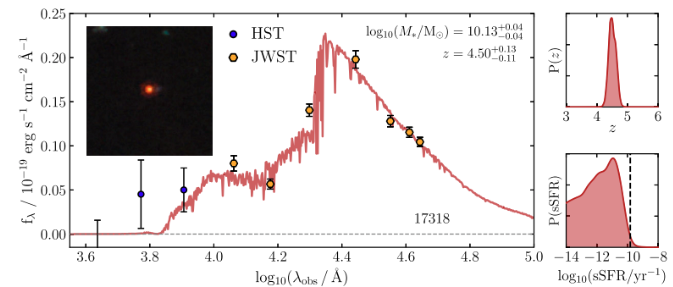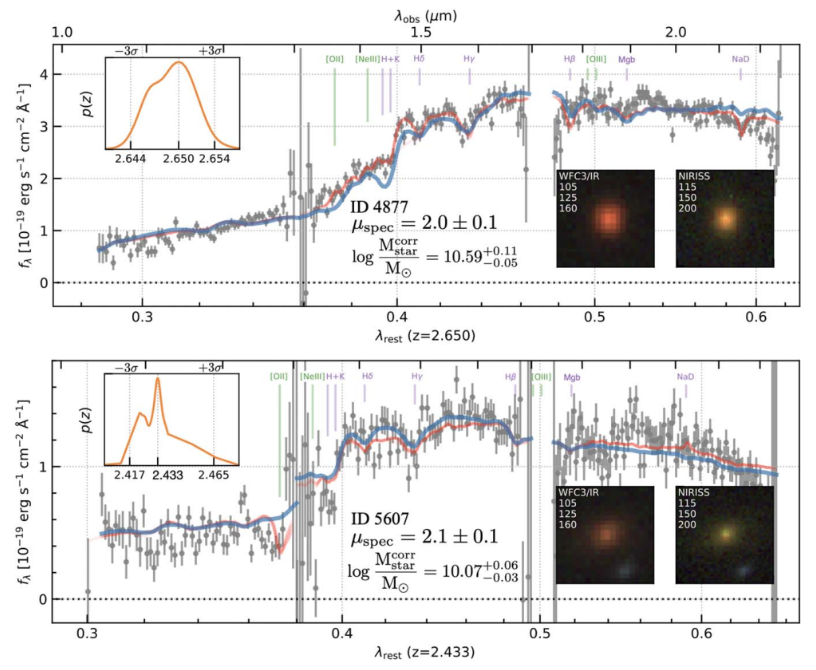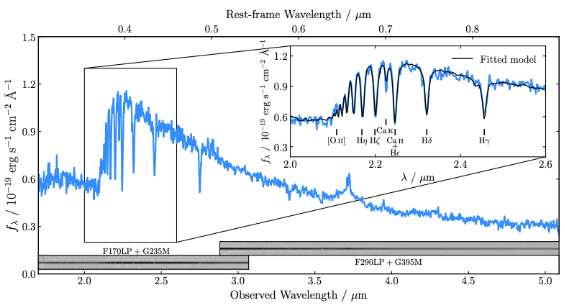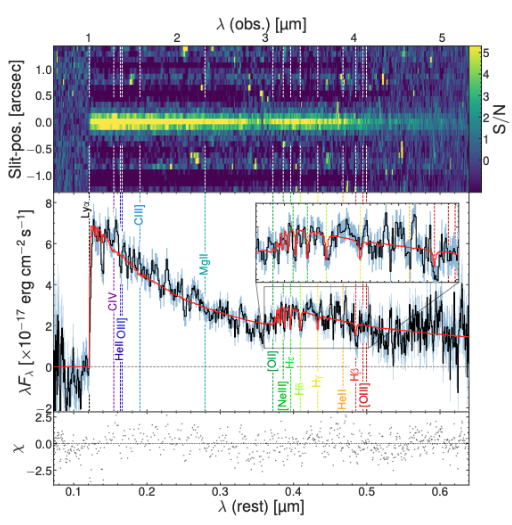Blog from May, 2023
https://ui.adsabs.harvard.edu/abs/2023MNRAS.520.3974C
Carnall et al. 2023
- They detected 10 massive quiescent galaxies at redshift, z > 3 from CEERS (Cosmic Evolution Early Release Science program)
- Using NIRCam photometry and SED fitting techniques
- Based on their findings, previous work appears to have underestimated the number of quiescent galaxies at 3 < z < 4 by a factor of 3–5
Example of one of the SED fitting strategies for a z~4.5 galaxy:
https://ui.adsabs.harvard.edu/abs/2023ApJ...942L..25M
Marchesini et al. 2023
- GLASS-JWST Early Release Science program
- Spectroscopic confirmation of two quiescent galaxies at z_spec = 2.650 and z_spec = 2.433 with relatively low stellar masses of >10^10.8 Ms
- The latter is the first spectroscopic confirmation of the existence of low-mass quiescent galaxies at cosmic noon.
https://ui.adsabs.harvard.edu/abs/2023arXiv230111413C
Carnall et al. 2023
- Spectroscopic confirmation of a massive quiescent galaxy, at z = 4.658, just 1.25 Gyr after the Big Bang,
- They used deep continuum observations from JWST NIRSpec
- It formed its stellar population over a 200 Myr period, approximately 600 − 800 Myr after the Big Bang (z = 7.3 ± 0.2), before quenching at z = 6.7 ± 0.3
Redshift estimates:
JWST NIRSpec observations of GS-9209 for a z~4.658 galaxy:
https://ui.adsabs.harvard.edu/abs/2023arXiv230313574G
Gelli et al. 2023
- The surprising JWST discovery of a quiescent, low-mass (M = 10^8.7M*) galaxy at redshift z = 7.3 (JADES-GS-z7-01-QU) represents a unique opportunity to study the imprint of feedback processes on early galaxy evolution
- They compare to simulated quiescent galaxies from the SERRA simulations
- By studying the SFH, they find that the observed abrupt quenching must be caused by radiation-driven winds, which are fast, instead of SNe which would take longer
Snapshots of the simulated galaxies used to investigate the physics behind the rapid quenching of high-redshift galaxies:
https://ui.adsabs.harvard.edu/abs/2023ApJ...945L..25K
Kokorev et al. 2023
- Using JWST/NIRCam images in the A2744 lensed cluster field, they identified a merging system that consists of a highly dusty, HST-dark, star-forming spiral galaxy (galaxy A) and a compact quiescent companion (galaxy B)
The figure shows the two galaxies (top panels) and their SED fitting (bottom panels) where the blue and green lines correspond to the best-fit model of the star-forming and quiescent galaxies, respectively.
https://ui.adsabs.harvard.edu/abs/2023arXiv230214155L
Looser et al. 2023
- A quiescent galaxy at z=7.3 (cosmic time 700 Myr).
- The JWST/NIRSpec spectrum of this galaxy from our JADES program exhibits a complete absence of nebular emission lines, while the Balmer break and Lyα drop are unambiguously detected.
- They infer a short and intense burst of star formation followed by rapid quenching, about 10–20 Myr before the epoch of observation.
- They propose a new empirical color selection technique designed to select massive quiescent galaxies at 3<z<6 using JWST NIRCam imaging data.
- They identified 44 candidate z~3 quiescent galaxies and derive volume density estimates in excellent agreement with existing reports on similar populations in the CEERS field.
The method consists on using empirically-constrained galaxy SED templates to define regions in color planes that seem to be unique of the quiescent galaxy population at z>3
https://iopscience.iop.org/article/10.3847/1538-4357/acbefa/pdf
Valentino et al., 2023
- Search for candidate quiescent galaxies in the distant universe in 11 public JWST fields covering 145 arcmin^2 (first 3 months since JWST started science operations)
- ∼80 candidate quiescent and quenching galaxies at 3 < z < 5
- The scatter among the various fields suggests cosmic variance
https://ui.adsabs.harvard.edu/abs/2022arXiv221211638N
Nanayakkara et al. 2023
- They report the finding of 5 new quiescent galaxies at z ≈ 3 − 4 with spectra obtained by JWST
- They used NIRSpec (with the MSA configuration)
 Rujopakarn+2023 - JWST AND ALMA IMAGING OF DUST-OBSCURED, MASSIVE SUBSTRUCTURES IN A TYPICAL z ∼ 3 STAR-FORMING DISK GALAXY
Rujopakarn+2023 - JWST AND ALMA IMAGING OF DUST-OBSCURED, MASSIVE SUBSTRUCTURES IN A TYPICAL z ∼ 3 STAR-FORMING DISK GALAXY
A massive MS galaxy at z~3, observed with both JWST and ALMA revealed the presence of mass structures associated with SF.
- substructures routinely identified in JWST studies (spiral arms, ...) but ALMA obs usually do not have the resolution to match them (see Wu+2023 Chen+2023)
This normal SF galaxy with 90% of SF and 70% of stellar mass concentrated in star-burst core. Substructures in stellar mass are spatially coincident with substructures in ALMA 240um continuum flux : SF associated to off-center substructures in stellar mass (substructures contain 5%SF, 10-30% stellar mass).
The stellar-mass substructures with ongoing SF might be a forming spiral arm or other types of disk instability from minor merger or interactions in an overdense environment (companions within 70kpc).
The location of the bulk of the stellar mass buildup is revealed to be co-located with the starburst core, affording a clearer picture of the galactic bulge during its assembly, and also galactic-disk substructures actively forming stars. Indicating a connection between disk instabilities and SF.
 Chen + 2022 - JWST Sneaks a Peek at the Stellar Morphology of z~2 Submillimeter Galaxies: Bulge Formation at Cosmic Noon
Chen + 2022 - JWST Sneaks a Peek at the Stellar Morphology of z~2 Submillimeter Galaxies: Bulge Formation at Cosmic Noon
With the advent of JWST, its sensitive high resolution observations at mid-infrared allows to directly image bulges. Before the evidence for the presence of bulges was indirect, through dynamics or for example by observations of submillimeter sizes found to be smaller than optical or NIR indicating dust obscured active SF in the center.
This study targeting 7 SMG, revealing the ubiquitous presence of a bulge component. Bulges sizes 0.7±1.0 kpc + often bars and spiral arms. 6/7 galaxies show tidal features or companions.
The first quantitative identification and characterisation of stellar bars at z > 1. based on rest-frame NIR F444W images of high resolution (∼1.3 kpc at z ∼ 1–3), including two highest redshift bars at z ∼ 2.136 and 2.312. Not full census yet.
The barred host galaxies have stellar masses ∼ 1 × 10^10 to 2 × 10^11 M, star formation rates of ∼ 21–295 M yr−1, and several have potential nearby companions which might play a role in the formation of these substructures.
The study demonstrates that bars form early in massive dynamically cold disks. projected semi-major axes of ∼ 2.9–4.3 kpc and moderate to high projected maximum ellipticities of ∼ 0.41–0.53 in the rest-frame NIR.
Study of a lensed sub-millimeter galaxy identified by ALMA at z~3 with NIRISS imaging and grism. This is a relatively massive MS galaxy. Here JWST resolved the galaxy down to 300 pc scale revealing the spiral structure.
- ALMA: compact dust core (2kpc) as in SMGs suggesting active bulge formation
- MS galaxy, SFR = 85+-30 Msun/yr, Star = 10^10.6 Msun, Re = 5kpc
- Group environment, spiral structure + SF core + inverted metallicity gradient might be due to minor merger
“The observed star formation at the bulge scale suggests an active bulge formation scenario, perhaps triggered by a minor merger.”
“compact dusty star formation in the core of A2744DSG-z3, a compact stellar component will remain in the center of the galaxy as the newly formed bulge.”
 Colina+2023 - Uncovering the stellar structure of the dusty star-forming galaxy GN20 at z=4.055 with MIRI/JWST
Colina+2023 - Uncovering the stellar structure of the dusty star-forming galaxy GN20 at z=4.055 with MIRI/JWST
- HST: offset between nucleus and UV emission (arc like structures) = 3.9 kpc.
- Nucleus coincides with peak FIR emission but offset by 1kpc wrt CO emission
- Stellar envelope offset wrt FIR and CO
- CO clumpy but similar size as the continuum
Stellar clumps == CO clumps or UV clumps
If nucleus == bulge the luminosity would imply very large stellar mass OR the nucleus could be nuclear starburst + agn (triggered by merger)
Similar to IR luminous galaxies of Chen2022 = large and low sersic number ~~ irregular galaxies.
They find among the clumps also very red - evolved - objects consistent with quenched, old stellar systems. No evidence for [OIII] emission from these red sources, suggesting that these are evolved globular clusters that formed at z~7-11. If confirmed with additional spectroscopy, these red, compact sparkles represent the first evolved globular clusters found at high redshift.















